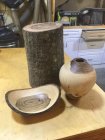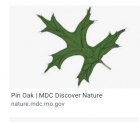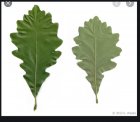I've only come across a few pieces of this over the years. The last time it was a tree already cut down and brush cleared so no leaves to examine. My friend more knowledgeable about trees calls it Swamp Oak. I made and sold a few items from it using that name. I came across two more pieces recently and again, no leaves to see. It was on a pile of logs from a cleared lot. I've looked online and I don't really see a lot of consistency in pictures of wood to be certain. The look is the same as before - pale sapwood and deep brown heartwood. I really like it and want to be on the lookout for more. I kow there are LOTS of different types of oak so hard to be sure sometimes. Some wood pictures of Pin Oak do look exactly like it, some don't.
-
We just finished moving the forums to a new hosting server. It looks like everything is functioning correctly but if you find a problem please report it in the Forum Technical Support Forum (click here) or email us at forum_moderator AT aawforum.org. Thanks! -
Beware of Counterfeit Woodturning Tools (click here for details) -
Johnathan Silwones is starting a new AAW chapter, Southern Alleghenies Woodturners, in Johnstown, PA. (click here for details) -
Congratulations to Dave Roberts for "2 Hats" being selected as Turning of the Week for April 22, 2024 (click here for details) -
Welcome new registering member. Your username must be your real First and Last name (for example: John Doe). "Screen names" and "handles" are not allowed and your registration will be deleted if you don't use your real name. Also, do not use all caps nor all lower case.
You are using an out of date browser. It may not display this or other websites correctly.
You should upgrade or use an alternative browser.
You should upgrade or use an alternative browser.
Swamp Oak?
- Thread starter Randy Anderson
- Start date
Pin Oak is what I was going to guess, I planted one of those in MN years ago and the nursery also alternately called it ‘Swamp’ oak.
First - I'm no tree expert. If you look online you find tree identification sites calling Pin Oak / Swamp Spanish Oak as the same tree. There's also a White Swamp Oak that is different from what I can tell. Wikipedia (not always the best of sources I know) has a good article on Pin Oak/Swamp Spanish Oak. At this point I'm calling it Swamp Oak and letting it ride.
White swamp oak is in the white oak group and pin oak (swamp Spanish oak) is in the red oak group. You can easily differentiate the two groups by looking closely at the end grain.
Rather than explain it here, take a look at this link with pictures and descriptions.
https://www.wood-database.com/wood-articles/distinguishing-red-oak-from-white-oak/
Rather than explain it here, take a look at this link with pictures and descriptions.
https://www.wood-database.com/wood-articles/distinguishing-red-oak-from-white-oak/
So there's swamp oak, which is not to be confused with swamp oak.
What we need is a DNA company. I can see it now: AssessTree.com
What we need is a DNA company. I can see it now: AssessTree.com
23andtree.com, or ancestree.com - sorry, just had to do it.
Good one, Randy!
If you're going to sell these pieces, or have happy family recipients, I'd suggest you refer to it as "Spanish Oak", regardless what species it is. Swamp Oak just doesn't have curb appeal.
If you're going to sell these pieces, or have happy family recipients, I'd suggest you refer to it as "Spanish Oak", regardless what species it is. Swamp Oak just doesn't have curb appeal.
When we had the wood ID problem from the Saint Father Damien tree, a few months ago, someone sent a piece of the wood to a University, they do wood ID. My memory is playing games with me right now.So there's swamp oak, which is not to be confused with swamp oak.
What we need is a DNA company. I can see it now: AssessTree.com
USDA Forest Products Lab in Madison WI will analyze wood samples.
https://www.fpl.fs.fed.us/research/centers/woodanatomy/wood_idfactsheet.php
https://www.fpl.fs.fed.us/research/centers/woodanatomy/wood_idfactsheet.php
Whatever it is called, the contrast between light and dark within the wood is wonderful.
Randy, I think you have red oak there. The hard defined heartwood in only in smaller/younger trees. Or in branch wood. The trunk wood would be close to void on the heartwood definition or should I say hard contrast. The smooth bark is another indicator. As previously mention this is in the red oak family and these trees grow readily in your area. The are capable of reaching very large size and grow well in the Ozark south of the Ohio river in Kentucky and Tennessee. That is what I think I know without a leaf that’s as close as I can get.




